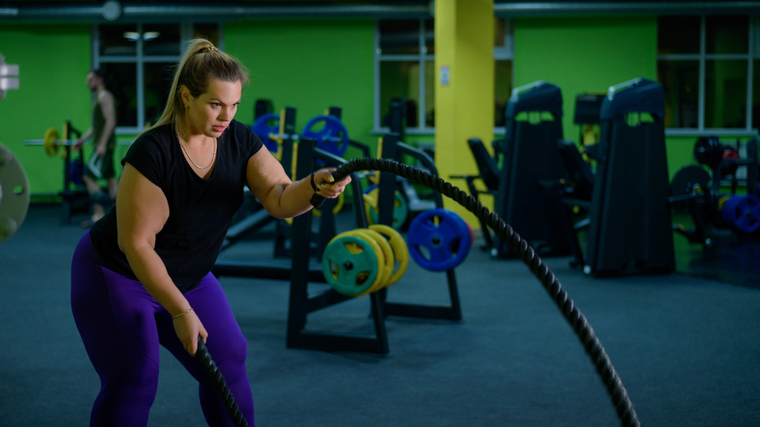You can squat more than twice your bodyweight, but can you climb the stairs to your apartment without getting overly winded? If you just hit a new bench press personal record but your shoulders aren’t mobile enough to help you reach into that tall cabinet for the fancy wine glasses, you might decide to take stock of your training style.
If you’re into exercises that prepare you for the things you might do in everyday life, functional fitness might be up your alley. Think about when you bend over to pick something up, lift your kid above your head, or use that strong grip for tug-of-war with your dog. Even more basic moves count — vacuuming the apartment, climbing a flight of stairs, and hauling your groceries into the car.

These may not feel like glamorous tasks or exercises in the moment, but any kind of movement requires activation from your muscles. If the muscles and movement patterns you need to use aren’t strong enough, that grocery run is going to be a lot more taxing than it might otherwise be. You can make your day-to-day a lot easier by adding some functional fitness activities into your gym life. Not to mention, functional fitness training can carryover into your more traditional training and help you get a lot stronger with a barbell.
What is Functional Fitness?
Functional fitness training is all about replicating movements you do everyday, often in a high-energy, high-intensity environment. This type of training isn’t just about doing lifts that look flashy in the gym — although it can look pretty cool (think: the CrossFit Games). This kind of training is fundamentally about supporting you throughout your daily tasks.
It’s a type of training that enhances your everyday life and your barbell-oriented training. In a typical functional fitness routine, you’ll perform full-body, compound movements that involve pushing, pulling, twisting, bending, and squatting — i.e., the fundamental movement patterns that you probably don’t even think about during your morning coffee run. When you help your friends move and they remind you to “lift with your legs, not your back,” they’re reminding you to squat. And if you do hinge at your hips to pick up that box, do it with proper deadlift form.
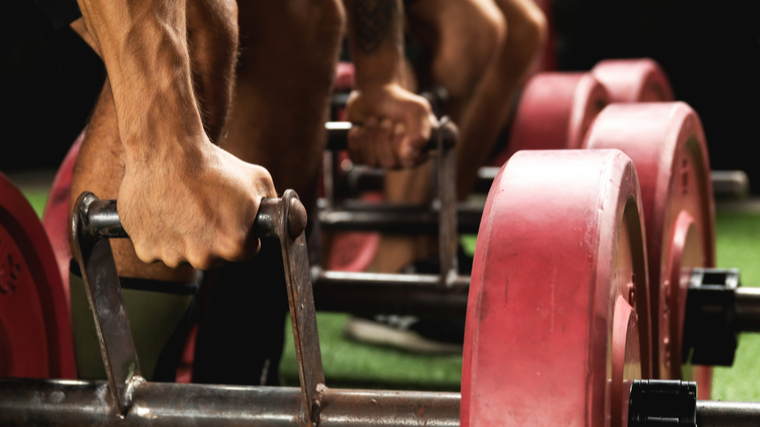
In addition to making you stronger, functional fitness improves balance, coordination, and your sense of movement and position. (1) Because of its full-body nature, functional fitness training also tends to improve your conditioning and work capacity. This leaves you better equipped to handle higher loads and work physically harder without as much fatigue.
Functional Fitness vs. Strength Training
Traditional strength training does focus on performing compound exercises — but you’re often aiming for a specific (relatively low) number of reps with ample rest periods. Many lifters will also include a fair amount of isolation exercises in their strength-based programming. For example, when you perform a biceps curl, your intention is likely to increase the strength or size of your biceps. You’re probably not thinking about how you’re going to use this in your daily life because, frankly, there aren’t many everyday movements that isolate just your biceps.
Functional fitness training focuses more on improving the bending, twisting, and squatting movements you do everyday. This kind of training also features explosive moves that may be less prominent in some strength-based programming. Think box jumps, heavy loaded carries, and a lot of AMRAP (as many rounds or reps as possible) work.
You may already be using functional fitness in your workout program without realizing it. Getting intentional about your programming can help get you stronger and more generally fit instead of having middling results on both fronts.
Benefits of Functional Fitness
You don’t have to be a CrossFitter to benefit from functional fitness training. If you tend to integrate moves like pull-ups and squats into your program, you’re likely to reap some of the benefits of functional fitness training.
Better Motor Function
In order to perform any type of movement, your muscles, brain, and nervous system all have to work together. Since functional fitness trains your neuromuscular system to work together under pressure, it can help improve movements used in the gym and daily life. High-intensity functional training — like the kind you’ll see featured in a lot of CrossFit workouts — can improve motor function over time. (2)

Sure, exercising with machines or other types of equipment can help you function more effectively in your daily life, especially if you’re just starting out. But functional training — with your bodyweight or dumbbells, for example — requires more of the same types of coordination and motor functioning that you need in everyday life.
Increased Strength
Traditional strength training is probably your first go-to when you think about increasing muscular strength. But functional training can also make you a lot stronger. Functional fitness training may even give you an edge over traditional strength training in terms of reinforcing positive movement patterns and strengthening your legs. (3) This may be because functional fitness training is more all-encompassing than traditional strength programming.
Better Conditioning and Endurance
Functional fitness training uses both your bodyweight and external loads like kettlebells, barbells, sandbags, or dumbbells in ways that improve your cardiovascular capacity and conditioning in a big way. (3) The better you are at performing specific functional fitness-focused workouts — like the CrossFit workout Fran, for example, which consists of a series of thrusters and pull-ups — the more strength and stamina you develop. (4)
When you’re strong and have good stamina, you’re on your way to becoming a well-conditioned person. Functional training helps you become someone who can not only pick up a heavy load of laundry, but also carry it as far as the nearest laundromat without too much trouble.
Improved Balance
Whether you’re in the gym or just walking through your neighborhood, balance is key. Without it, you put yourself at a greater risk of tripping on the sidewalk or missing big lifts on the platform. Functional fitness helps train your mind and muscles for everyday activities that require a lot of balance and full-body stability. (5) If you identify as a klutz, it behooves you to integrate some functional agility training or speed work into your training. That way, you’ll be less likely to take a spill at an inconvenient (and potentially injury-inducing) moment.
More Speed and Power
Traditional strength training helps you build muscle, endurance, strength, and boost your bone density. But if you rely on speed and power for your sport or daily activities, all that may not be enough. Functional fitness can help fill in those gaps. (6)
Credit: Reshetnikov_art / Shutterstock
Compared to strength training, functional fitness can provide greater improvement to the way you move in and outside the gym. (7)
Sport-Specific Carryover
Functional fitness won’t just get you better at vacuuming your apartment. You’ll also improve at any number of sports. Functional training can help improve sport-specific endurance because it focuses on the main movement patterns that you’re using when you throw or catch a ball, swing a racket, run down a field, jump off the ground, or wrestle an opponent. (8) When you perform exercises that closely mimic the moves you do in your sport — like how deadlifts help you lift and pull heavy things — you can find more purpose in functional fitness. (6)
Programming Functional Fitness
Throwing loaded carries into your training without thought for how and why they’re there isn’t necessarily going to give you the best of both worlds. Figuring out how to integrate functional fitness training into your strength program is all about combining your experience level with your goals.
High-Intensity Functional Training (HIFT)
CrossFit can be considered high-intensity functional training because it combines the energy of high-intensity interval training (HIIT) with the functionality of moves like overhead lunges, loaded carries, and pulling and pushing heavy weights. A lot of these workouts also have military training as their inspiration, which takes into account strength, cardiovascular endurance, agility, and overall ability to cope with whatever physical obstacles are thrown at you. (9)

HIFT can put a lot of stress on your body, especially if you’re in the gym seven days a week. Doing an intense functional workout three to five days per week can combine results with enough recovery to keep your muscles strong and healthy. (10) If you don’t have a strong cardiovascular base, start with only one or two of these sessions a week and build from there.
Getting your heart rate up with workouts like AMRAPs and EMOMs (every minute, on the minute) can be a simple way to incorporate HIFT.
Sample Functional Fitness Workout for Conditioning
Perform this workout one to five times a week, depending on your experience level and the intensity of the rest of your program. It’s geared toward conditioning, so integrate it into your program after your strength training when you want to boost your work capacity.
- Pull-Up: 10
- Jump Squat: 15
- Push-Up: 15
- Box Jump: 10
- 100-meter Sprint or 200-meter Row
- Repeat AMRAP for 10 to 20 minutes
Scale the movements as needed, using resistance bands to help with your pull-ups or swapping them entirely for inverted rows.
Isometrics
If you’re doing it right, your body won’t look like it’s working all that hard during isometric training. That’s because isometrics involve you staying still, holding a muscle in its contracted position with no joint movement. For example, you might perform a pause squat where you hold at the bottom for three to five seconds. You’ll be increasing your time under tension and priming your muscles for peak muscle growth and endurance-building.
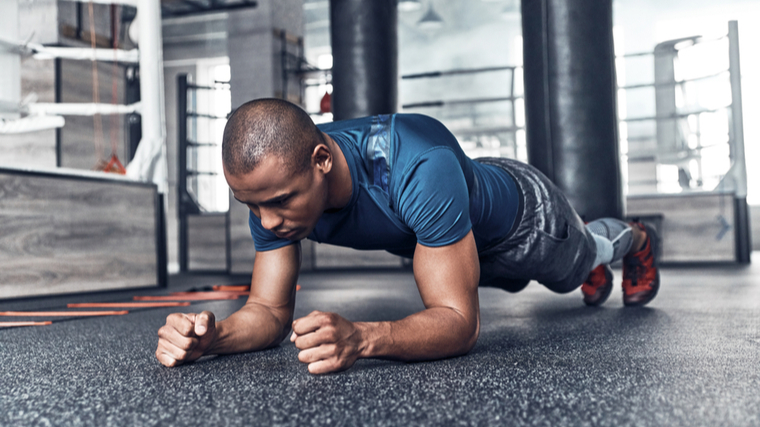
To get functional benefits from isometrics, think of movements you do everyday — sit, stand up, carry, reach overhead, push, pull. Performing exercises that mimic these movements and holding them for three to eight seconds could help your training and daily life. Incorporating isometrics two times per week for 10 minutes of your workout can be enough to build strength and break through plateaus.
Sample Functional Fitness Workout for Muscular Endurance
You might use this circuit as a finisher after your strength training. You’ll incorporate your entire body, overloading your core and smoking your legs. Make sure you don’t do this the day before leg day.
- Pause Squat: 5 reps with a three second hold at the bottom
- Overhead Carry: 40 meters
- Repeat AMRAP for 15 minutes
If you’re new to isometric work and this kind of intensive endurance training, go lighter on the weights until your body can acclimate to these demands.
Core Stability
Although you may not realize it, just about anytime you move, you use your core for stabilization. Your core muscles create a solid foundation for the rest of your body. So whether you’re moving in the gym or walking down the street, you need your core to assist with the movement.
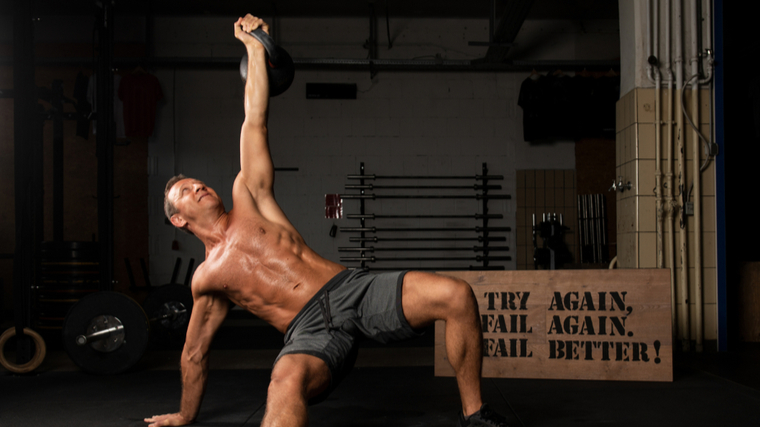
Incorporating core stability training can not only help you achieve that six-pack if you want it, but it can also help improve core mobility. All that makes twisting, turning, and bending that much easier. (11) Functionally training your core two to three times per week after your regular workout routine can tax your core without making it too tough to recover for your bigger compound movements like deadlifts, squats, and overhead presses.
Sample Functional Fitness Workout for Core Stability
- Turkish Get-Up: 4 reps, right side
- Unilateral Suitcase Carry: 40 meters, right side
- Turkish Get-Up: 4 reps, left side
- Unilateral Suitcase Carry: 40 meters, left side
- Repeat AMRAP for 15 minutes
Maybe you don’t have access to 40 uninterrupted meters of space, or you’re not sure exactly how big your space is. That’s okay — stay consistent and work with what you have.
Unilateral Training
In everyday life, side dominance probably dictates how you go about your tasks. If you’re right-handed, you’re likely doing everything from chopping vegetables to carrying your gym bag on your right side. If you only ever train with barbells, the strength imbalances that may follow might seep into your training. When your body has to compensate for a relative weakness on one side, you’re setting yourself up for suboptimal lifts at best and potential training injuries at worst.
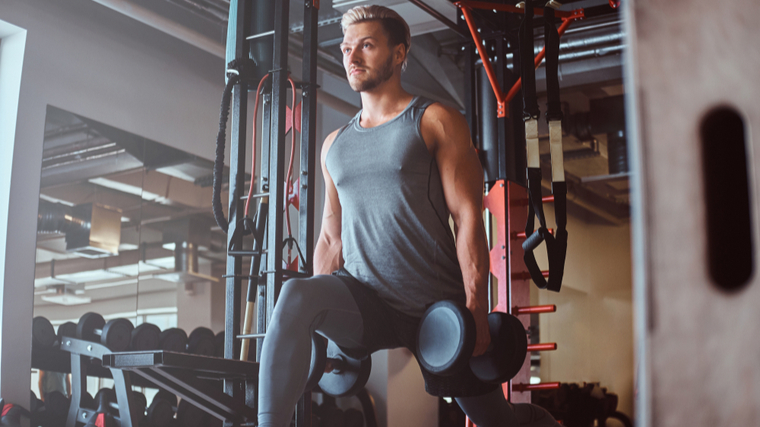
Training both sides of your body independently is one of the most functional things you can do every day that you train to both improve your lifting and day-to-day movements. To address these strength and muscle imbalances, you don’t have to program exclusively unilateral sessions (though you can). Just try to be mindful of subbing out your barbell in favor of dumbbells or kettlebells when you can. Include unilateral lower body moves like lunges and split squats in your regular routine.
Sample Function Fitness Workout for Unilateral Training
You don’t have to program fully unilateral sessions — they’re easy to pepper into your regularly-scheduled sessions as accessory moves. However, if you know you need the extra attention to balancing your muscles and strength, try this session out two or three times a week.
- Lunge: 10 (right side)
- Unilateral Overhead Press: 10 (right side)
- Split Squat: 10 (right side)
- One-Arm Kettlebell Swing: 10 (right side)
- Lunge: 10 (left side)
- Unilateral Overhead Press: 10 (left side)
- Split Squat: 10 (left side)
- One-Arm Kettlebell Swing: 10 (left side)
- Repeat AMRAP for 15 minutes
You can perform your lunges and split squats unweighted if you need to. Scale up the weights slowly when the time comes to keep your form excellent.
Function Well
If you’ve ever pushed a sled, carried a heavy kettlebell, or cranked out some pull-ups to finish off your pull day, you’ve used functional fitness training into your workout. Any time you lunge, hinge, or rotate can be considered functional training. Whether your main goal is to improve movement outside the gym, crush your next max squat attempt, or be the coolest kid in your CrossFit box, sprinkling functional fitness training into your program can help you get there.
References
- Beckham, Susan G., Harper, Michael M. Functional Training: Fad or Here to Stay? ACSM’s Health & Fitness Journal. 2010; 14(6). doi: 10.1249/FIT.0b013e3181f8b3b7
- Wilke, Jane, Mohr, Lisa. Chronic effects of high-intensity functional training on motor function: a systematic review with multilevel meta-analysis. Scientific Reports. 2020; 10.
- Resendo-Neto, Antonio Gomes de, Aragao-Santos, José Carlos, & Olivieira-Andrade, Bruna Carolina. The Efficacy of Functional and Traditional Exercise on the Body Composition and Determinants of Physical Fitness of Older Women: A Randomized Crossover Trial. Journal of Aging Research. 2019. https://doi.org/10.1155/2019/5315376
- Cavedon, Valentina, Milanese, Chiara, & Marchi, Alessandro. Different amount of training affects body composition and performance in High-Intensity Functional Training participants. PLOSOne. 2020; https://doi.org/10.1371/journal.pone.0237887
- Guler, Ozkan, Tuncel, Oguzhan, Bianco, Antonino. Effects of Functional Strength Training on Functional Movement and Balance in Middle-Aged Adults. Sustainability. 2021; 13(3). https://doi.org/10.3390/su13031074
- Xiao, Wensheng, Soh, Kim Geok, & Wazir, Mohd Rozilee Wazir Norjali. Effect of Functional Training on Physical Fitness Among Athletes: A Systematic Review. Frontiers in Physiology. 2021. https://doi.org/10.3389/fphys.2021.738878
- Da Silva-Grigoletto, Marzo, Mesquita, Marceli M. A., & Aragao-Santos, Jose C. Functional Training Induces Greater Variety and Magnitude of Training Improvements than Traditional Resistance Training in Elderly Women. Journal of Sports Science and Medicine. 2019; 18(4).
- Osipov, Aleksander, Kudryavtsev, Mikhail, & Gatilov, Konstantin. The use of functional training – crossfit methods to improve the level of special training of athletes who specialize in combat sambo. Journal of Physical Education and Sport. 2017; 17(3). DOI:10.7752/jpes.2017.03201
- Weiss, Tiana, Kreitinger, Jerica, & Wilde, Hilary. Effect of Functional Resistance Training on Muscular Fitness Outcomes in Young Adults. Journal of Exercise Science and Fitness. 2010; 8(2). https://doi.org/10.1016/S1728-869X(10)60017-2
- Haddock, Christopher K., Poston, Walker S. C., & Heinrich, Katie M. The Benefits of High Intensity Functional Training (HIFT) Fitness Programs for Military Personnel. Mil Med. 2016; 181(11). doi: 10.7205/MILMED-D-15-00503
- Mahmood, Wajeeha, Ehsan, Sarah, & Sagheer, Basita. Effect of core stabilization exercises in addition to conventional therapy in improving trunk mobility, function, ambulation and quality of life in stroke patients: a randomized controlled trial. BMC Sports Science, Medicine and Rehabilitation. 2022; 14(62).
Featured Image: StratfordProductions / Shutterstock
